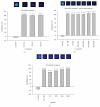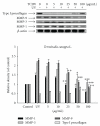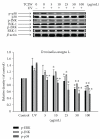Inhibitory Effects of Terminalia catappa on UVB-Induced Photodamage in Fibroblast Cell Line
- PMID: 20981325
- PMCID: PMC2958628
- DOI: 10.1155/2011/904532
Inhibitory Effects of Terminalia catappa on UVB-Induced Photodamage in Fibroblast Cell Line
Abstract
This study investigated whether Terminalia catappa L. hydrophilic extract (TCLW) prevents photoaging in human dermal fibroblasts after exposure to UVB radiation. TCLW exhibited DPPH free radical scavenging activity and protected erythrocytes against AAPH-induced hemolysis. In the gelatin digestion assay, the rates of collagenase inhibition by TCL methanol extract, TCLW, and its hydrolysates were greater than 100% at the concentration of 1 mg/mL. We found that serial dilutions of TCLW (10-500 μg/mL) inhibited collagenase activity in a dose-dependent manner (82.3% to 101.0%). However, TCLW did not significantly inhibit elastase activity. In addition, TCLW inhibited MMP-1 and MMP-9 protein expression at a concentration of 25 μg/mL and inhibited MMP-3 protein expression at a concentration of 50 μg/mL. TCLW also promoted the protein expression of type I procollagen. We also found that TCLW attenuated the expression of MMP-1, -3, and -9 by inhibiting the phosphorylation of ERK, JNK, and p38. These findings suggest that TCLW increases the production of type I procollagen by inhibiting the activity of MMP-1, -3 and -9, and, therefore, has potential use in anti-aging cosmetics.
Figures









Similar articles
-
Protective effects and mechanisms of Terminalia catappa L. methenolic extract on hydrogen-peroxide-induced oxidative stress in human skin fibroblasts.BMC Complement Altern Med. 2018 Oct 1;18(1):266. doi: 10.1186/s12906-018-2308-4. BMC Complement Altern Med. 2018. PMID: 30285714 Free PMC article.
-
Ixora parviflora Protects against UVB-Induced Photoaging by Inhibiting the Expression of MMPs, MAP Kinases, and COX-2 and by Promoting Type I Procollagen Synthesis.Evid Based Complement Alternat Med. 2012;2012:417346. doi: 10.1155/2012/417346. Epub 2011 Dec 1. Evid Based Complement Alternat Med. 2012. PMID: 22203872 Free PMC article.
-
Michelia alba extract attenuates UVB-induced expression of matrix metalloproteinases via MAP kinase pathway in human dermal fibroblasts.Food Chem Toxicol. 2012 Dec;50(12):4260-9. doi: 10.1016/j.fct.2012.08.018. Epub 2012 Aug 17. Food Chem Toxicol. 2012. PMID: 22922035
-
Isoflavonoid-Rich Flemingia macrophylla Extract Attenuates UVB-Induced Skin Damage by Scavenging Reactive Oxygen Species and Inhibiting MAP Kinase and MMP Expression.Evid Based Complement Alternat Med. 2013;2013:696879. doi: 10.1155/2013/696879. Epub 2013 Jul 1. Evid Based Complement Alternat Med. 2013. PMID: 23935672 Free PMC article.
-
Neonauclea reticulata (Havil.) Merr Stimulates Skin Regeneration after UVB Exposure via ROS Scavenging and Modulation of the MAPK/MMPs/Collagen Pathway.Evid Based Complement Alternat Med. 2013;2013:324864. doi: 10.1155/2013/324864. Epub 2013 Jun 15. Evid Based Complement Alternat Med. 2013. PMID: 23843873 Free PMC article.
Cited by
-
Protective effects and mechanisms of Terminalia catappa L. methenolic extract on hydrogen-peroxide-induced oxidative stress in human skin fibroblasts.BMC Complement Altern Med. 2018 Oct 1;18(1):266. doi: 10.1186/s12906-018-2308-4. BMC Complement Altern Med. 2018. PMID: 30285714 Free PMC article.
-
Protective effects of tetrahydrocurcumin (THC) on fibroblast and melanoma cell lines in vitro: it's implication for wound healing.J Food Sci Technol. 2017 Apr;54(5):1137-1145. doi: 10.1007/s13197-017-2525-8. Epub 2017 Feb 27. J Food Sci Technol. 2017. PMID: 28416863 Free PMC article.
-
Gastric antiulcerogenic and hypokinetic activities of Terminalia fagifolia Mart. & Zucc. (Combretaceae).Biomed Res Int. 2014;2014:261745. doi: 10.1155/2014/261745. Epub 2014 May 12. Biomed Res Int. 2014. PMID: 24900960 Free PMC article.
-
Indian Almond (Terminalia catappa Linn.) Leaf Extract Extends Lifespan by Improving Lipid Metabolism and Antioxidant Activity Dependent on AMPK Signaling Pathway in Caenorhabditis elegans under High-Glucose-Diet Conditions.Antioxidants (Basel). 2023 Dec 20;13(1):14. doi: 10.3390/antiox13010014. Antioxidants (Basel). 2023. PMID: 38275634 Free PMC article.
-
Pinus densiflora extract protects human skin fibroblasts against UVB-induced photoaging by inhibiting the expression of MMPs and increasing type I procollagen expression.Toxicol Rep. 2014 Aug 29;1:658-666. doi: 10.1016/j.toxrep.2014.08.010. eCollection 2014. Toxicol Rep. 2014. PMID: 28962279 Free PMC article.
References
-
- Lin C-C, Chen Y-L, Lin JM, Ujiie T. Evaluation of the antioxidant and hepatoprotective activity of Terminalia catappa . American Journal of Chinese Medicine. 1997;25(2):153–161. - PubMed
-
- Chen P-S, Li J-H. Chemopreventive effect of punicalagin, a novel tannin component isolated from Terminalia catappa, on H-ras-transformed NIH3T3 cells. Toxicology Letters. 2006;163(1):44–53. - PubMed
-
- Chu S-C, Yang S-F, Liu S-J, Kuo W-H, Chang Y-Z, Hsieh Y-S. In vitro and in vivo antimetastatic effects of Terminalia catappa L. leaves on lung cancer cells. Food and Chemical Toxicology. 2007;45(7):1194–1201. - PubMed
-
- Kinoshita S, Inoue Y, Nakama S, Ichiba T, Aniya Y. Antioxidant and hepatoprotective actions of medicinal herb, Terminalia catappa L. from Okinawa Island and its tannin corilagin. Phytomedicine. 2007;14(11):755–762. - PubMed
-
- Tan GT, Pezzuto JM, Kinghorn AD, Hughes SH. Evaluation of natural products as inhibitors of human immunodeficiency virus type 1 (HIV-1) reverse transcriptase. Journal of Natural Products. 1991;54(1):143–154. - PubMed
LinkOut - more resources
Full Text Sources
Research Materials
Miscellaneous

